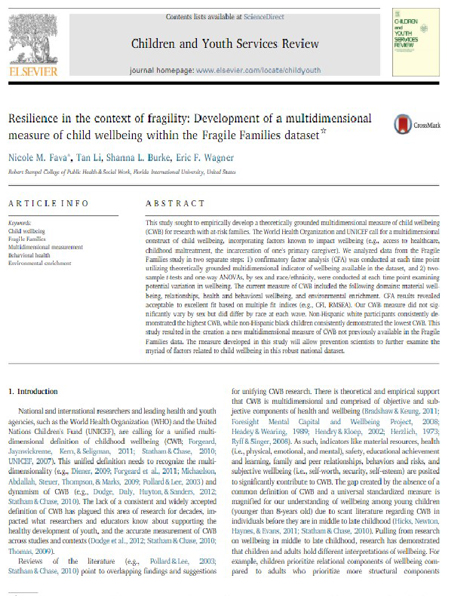Resilience in the context of fragility: Development of a multidimensional measure of child wellbeing within the Fragile Families dataset
 Abstract: This study sought to empirically develop a theoretically grounded multidimensional measure of child wellbeing (CWB) for research with at-risk families. The World Health Organization and UNICEF call for a multidimensional construct of child wellbeing, incorporating factors known to impact wellbeing (e.g., access to healthcare, childhood maltreatment, the incarceration of one’s primary caregiver). We analyzed data from the Fragile Families study in two separate steps: 1) confirmatory factor analysis (CFA) was conducted at each time point utilizing theoretically grounded multidimensional indicator of wellbeing available in the dataset, and 2) twosample t-tests and one-way ANOVAs, by sex and race/ethnicity, were conducted at each time point examining potential variation in wellbeing. The current measure of CWB included the following domains: material wellbeing, relationships, health and behavioral wellbeing, and environmental enrichment. CFA results revealed acceptable to excellent fit based on multiple fit indices (e.g., CFI, RMSEA). Our CWB measure did not significantly vary by sex but did differ by race at each wave. Non-Hispanic white participants consistently demonstrated the highest CWB, while non-Hispanic black children consistently demonstrated the lowest CWB. This study resulted in the creation a new multidimensional measure of CWB not previously available in the Fragile Families data. The measure developed in this study will allow prevention scientists to further examine the myriad of factors related to child wellbeing in this robust national dataset.
Abstract: This study sought to empirically develop a theoretically grounded multidimensional measure of child wellbeing (CWB) for research with at-risk families. The World Health Organization and UNICEF call for a multidimensional construct of child wellbeing, incorporating factors known to impact wellbeing (e.g., access to healthcare, childhood maltreatment, the incarceration of one’s primary caregiver). We analyzed data from the Fragile Families study in two separate steps: 1) confirmatory factor analysis (CFA) was conducted at each time point utilizing theoretically grounded multidimensional indicator of wellbeing available in the dataset, and 2) twosample t-tests and one-way ANOVAs, by sex and race/ethnicity, were conducted at each time point examining potential variation in wellbeing. The current measure of CWB included the following domains: material wellbeing, relationships, health and behavioral wellbeing, and environmental enrichment. CFA results revealed acceptable to excellent fit based on multiple fit indices (e.g., CFI, RMSEA). Our CWB measure did not significantly vary by sex but did differ by race at each wave. Non-Hispanic white participants consistently demonstrated the highest CWB, while non-Hispanic black children consistently demonstrated the lowest CWB. This study resulted in the creation a new multidimensional measure of CWB not previously available in the Fragile Families data. The measure developed in this study will allow prevention scientists to further examine the myriad of factors related to child wellbeing in this robust national dataset.
Fava, N.M., Li, T., Burke, S.L., & Wagner, E.F. (2017). Resilience in the context of fragility: Development of a multidimensional measure of child wellbeing within the Fragile Families dataset. Children & Youth Services Review, 81358-367. doi:10.1016/j.childyouth.2017.08.023
